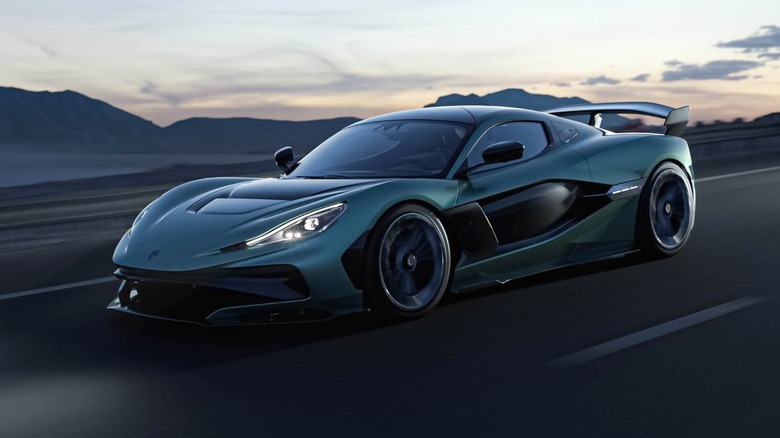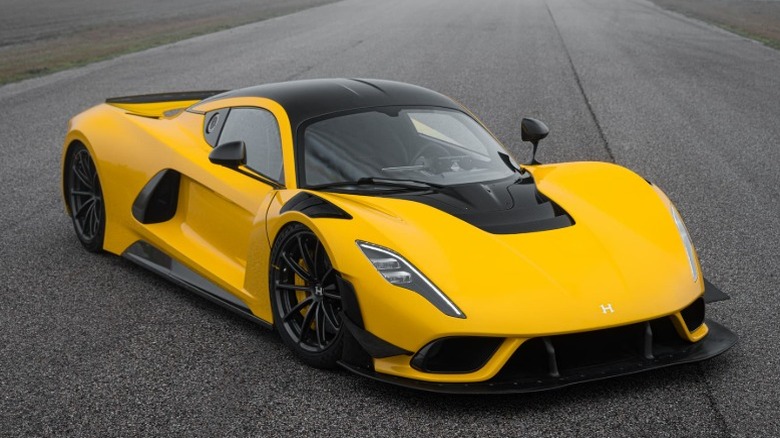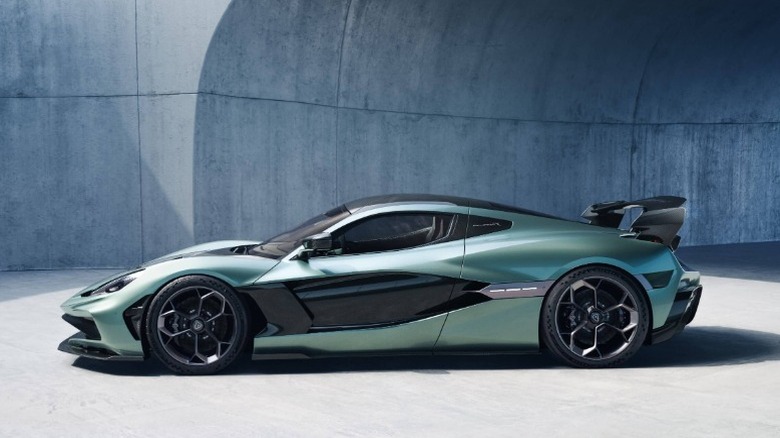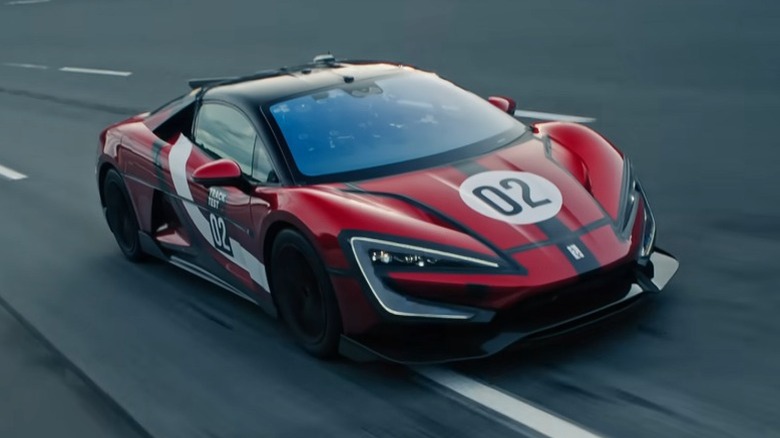5 Cars With More Horsepower Than A Bugatti Veyron
When it debuted in 2005, the Bugatti Veyron was something of a sensation. And even that may be selling the hypercar a bit short: With a then-incredible 1,001 ps (or 987 hp) on tap from its immense quad-turbo W-16 engine and a claimed 0-60 mph time of 2.5 seconds, the Veyron was a production car unlike the world had ever seen. Reviewers of the time raved about it, and it featured regularly on "Top Gear," including a memorable top-speed run with James May behind the wheel.
As crazy as the Veyron was at the time, there was more to come. Bugatti unveiled the Veyron Super Sport in 2010, which cranked power up to 1,200 hp, set a production car land speed record of 431 km/h (267.81 mph), and duly won the "Top Gear" Car of the Year award — all in the same year.
While the Veyron's place in automotive history is assured, the past few years of high-end motoring have not been kind to the Veyron's power numbers. 1,200 hp may have been astounding for 2010, but the 2020s have seen high-performance automobiles flirt with and surpass the 2,000-hp barrier, helped by the wonders of electrification. Let's take a quick look at a handful of cars that have exceeded the Veyron Super Sport's 1,200 hp — Bugattis not included, just to keep things varied.
Xiaomi SU7 Ultra - 1,526 hp
If you'd told "Top Gear"'s Jeremy Clarkson in 2010 that a car from a smartphone and appliance manufacturer would one day make more power than the Veyron Super Sport, he'd probably have laughed you out of the building. But that's exactly the world in which we live today, thanks to the Xiaomi SU7 Ultra.
The SU7 Ultra, which is easily one of the most powerful sedans ever made, is a triple-motor EV producing a heady 1,526 hp. Even with its significant kerb weight of around 5,200 pounds, that's good enough to take it to 62 mph in 1.98 seconds — half a second faster than the original Veyron from 2005. The icing on the cake? The SU7 Ultra debuted with a price tag of just over $70,000, orders of magnitude cheaper than the Veyron's $1.2 million asking price (not accounting for inflation, mind you). No wonder, then, that Xiaomi allegedly sold 10,000 SU7 Ultras in just two hours when it launched in China.
Xiaomi's SU7 Ultra doesn't just beat the Veyron (and the Veyron Super Sport) in terms of the raw numbers and straight-line performance, either. The Veyron managed a 7:40 lap time at the legendary Nürburgring circuit, which wasn't bad in its day, but the SU7 Ultra destroyed that with a 7:04 lap when it took to the Green Hell in 2025. Twenty years is a long time, especially at the sharp end of high-performance motoring, and it shows.
SSC Tuatara - 1,750 hp
Many of the most powerful hypercars in the world rely on electification of some sort. Whether it's a hybrid powertrain — like the Koenigsegg Gemera — or full-on battery power, such as with the Lotus Evija, electric motors have now become essential for the stratospheric power numbers in modern hypercars. But while that's all well and good, there's still something to be said about a traditional, big-power combustion engine like the one present in the SSC Tuatara.
The SSC Tuatara packs a twin-turbocharged, 5.9-liter V8 that makes 1,750 hp and 1,280 lb-ft of torque on E85, sent to the rear wheels via an automated manual seven-speed transmission. These numbers make it more powerful than even some of the Veyron's successors, such as the Chiron and Divo, but don't think it relies on E85 to outmuscle the Veyron: even on pump gas, the Tuatara's V8 makes a Veyron Super Sport-beating 1,350 hp. This sheer power helped the street-legal Tuatara hit an official top speed of 295 mph, significantly faster than the Bugatti's run all those years ago, with allegedly more to give.
The price for all this performance? $2 million or thereabouts, which, as far as too-fast-for-its-clientele hypercars go, isn't all that bad, really. SSC has even crazier variants of the Tuatara available for those with even deeper pockets (and confidence in their driving ability), too: the Tuatara Aggressor, a track-only version, makes 2,200 hp on methanol.
Hennessey Venom F5 Evolution - 2,031 hp
Trust the Americans to keep flying the flag for internal combustion. Hennessey has long had a reputation for making bonkers gasoline-fueled hypercars, with the most powerful of its offerings easily breaking past the 1,200-hp barrier. As impressive as those are, though, we'd argue that it's outdone itself with its latest offering.
The Hennessey Venom F5 Evolution is an even hotter, souped-up version of the 1,817-hp Hennessey Venom F5 we had the pleasure of driving in 2024. The F5 Evolution, a $285,000 package on top of the roughly $3 million base car, brings improvements such as a revised turbocharger setup and new pistons to the Venom F5's 6.6-liter "Fury" V8, taking power past the 2,000-hp mark. Torque is also up, with the F5's 1,193 lb-ft climbing to 1,445 lb-ft with the Evolution package. All of these numbers are on E85, naturally, although Hennessey has declined to offer power numbers when the Venom F5 is limited to pump gas.
Now, while the numbers are undoubtedly the most eye-catching aspect of the F5 Evolution, this new flagship Hennessey hypercar isn't just a Venom F5 with more straight-line grunt. It has an adaptive suspension setup that is allegedly both more pliant on the road and even sharper on track, while the Evolution package also adds a redesigned front splitter and undercarriage with better aerodynamic performance.
Rimac Nevera R - 2,107 hp
Let's face it: Hypercars are silly — but undeniably impressive feats of engineering. Few of us will ever experience all that greatness, so looking at the numbers is all we can do. That may be a bit pointless, but it's still fun.
We're talking about the Rimac Nevera R EV hypercar, which broke a remarkable 24 production car records in a single day in July 2025. Amongst these records were: the quickest 0-60 mph time (1.66 seconds), the quickest 0-200 mph time (9.25 seconds), the quickest 0-250-0 mph time (26.2 seconds), and the quickest quarter mile time (7.90 seconds). An astounding set of achievements, even for a car that costs north of $2.2 million.
Now, whether any of these Nevera R records really matter is a whole other thing, of course, but that's beside the point here. The crucial aspect, at least for this list, is that the Nevera R managed its searing speed record feats courtesy of a quad-motor setup that makes a total of 2,107 hp, just over double that of the original Veyron. One area where the Nevera R isn't quite a world-beater, perhaps, is in top speed; it tops out at a claimed 430 km/h (267.18 mph), about the same as the Veyron Super Sport — although one can assume that's likely by design, given Rimac's focus on downforce and grip with the Nevera R.
Yangwang U9 Xtreme - ~3000 hp
What's more ludicrous than a 2,100-hp EV? One that makes 3,000 hp, of course. That's what Yangwang, the performance division of the Tesla-rivaling Chinese EV maker BYD, has offered to the world with the U9 Xtreme. The standard U9 already had some fancy tricks up its sleeve, including driving with only three wheels, but what it didn't have was world-beating power: with just 1,288 hp on tap, the U9 wasn't nearly powerful enough to trouble the Rimacs of the world.
That's all changed with the U9 Xtreme. Officially unveiled in September 2025, the U9 Xtreme made an immediate splash by breaking a couple of notable production car speed records. It smashed top speed records in both EV and general production car categories. First, it hit 472.41 km/h (293 mph) to claim the EV record, then surpassed the Bugatti Chiron Super Sport's 304 mph to set the overall production car record at 496.22 km/h (308.33 mph). It also set a Nürburgring EV record in October, with a time of 6:59.
The U9 Xtreme retains the U9's battery and DiSus suspension, although the latter has been tweaked for better circuit performance. The big difference, though, is in the electrics: the U9 Xtreme has a 1,200-volt system (vs. 800 volts) and uses four motors instead of just two. The result is power output comfortably in the 3,000-hp range, although we don't know how much exactly: some sources state that it makes 2,200 kW (2,977 hp), while Yangwang says it has more than 3,000 hp. Pricing isn't clear either, although it likely won't matter for most of us anyway, given that Yangwang's only making 30.





